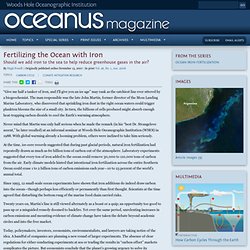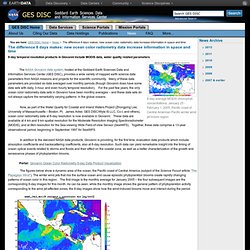

Ocean Tracks. Oceanus : Fertilizing the Ocean with Iron. By Hugh Powell :: Originally published online : In print Vol. 46, No. 1, Jan. 2008 “Give me half a tanker of iron, and I’ll give you an ice age” may rank as the catchiest line ever uttered by a biogeochemist.

The man responsible was the late John Martin, former director of the Moss Landing Marine Laboratory, who discovered that sprinkling iron dust in the right ocean waters could trigger plankton blooms the size of a small city. In turn, the billions of cells produced might absorb enough heat-trapping carbon dioxide to cool the Earth’s warming atmosphere. Never mind that Martin was only half serious when he made the remark (in his “best Dr. Strangelove accent,” he later recalled) at an informal seminar at Woods Hole Oceanographic Institution (WHOI) in 1988. At the time, ice-core records suggested that during past glacial periods, natural iron fertilization had repeatedly drawn as much as 60 billion tons of carbon out of the atmosphere. Not as simple as it sounds But is it legal? Www.whoi.edu/fileserver.do?id=125345&pt=2&p=131849. Hahana.soest.hawaii.edu/agouroninstitutecourse/laws_pdf.pdf.
Ocean Productivity. As stated above, Custom Products provides ocean productivity estimates for different satellite data sets and alternative productivity algorithms.

Currently, the two alternative algorithms are an "Eppley" version of the VGPM and the recently described Carbon-based Production Model (CbPM) (Behrenfeld et al. 2005, Westberry et al. 2008). Examples of annual total productivity for the Standard VGPM, the Eppley-VGPM, and the CbPM are shown below to illustrate the rather significant differences between models. Additional comparisons on shorter time scales can be viewed on the Custom Products page. Homepage. Bioapplications-of-algae. Oceanexplorergov. Reference: Ocean Survival is Our Survival. Ocean Survival is Our Survival The oceans are dying . This is not a new thing, it happend several times in the world's history. The causes have differend but one recurring trigger has often been rapid climate change, either warming or cooling.
We now experience warming due to CO2 emissions . According to some experts Global Warming should be called Ocean Warming, as 80% of the heat ends up in our oceans . Similarities in previous extinctions Extinctions through the ages (showing percentage of marine life that went extinct) The killer substance that will becomes abundant in the deep oceans once the currents stop is Hydrogen Sulfide , a colorless, very poisonous, flammable gas with the characteristic foul odor of rotten eggs. Article about the scar of H2S in our present species A book was written about the end Permian extinction, more here Gary Schaffer predicts mass dieoffs due to deoxigenation. Johm Alroy sees potential dieoff due to multiple factors. NASA Visualizes The World’s Ocean Currents, Van Gogh-Style. NASA Goddard Scientific Visualization Studio created an animation visualizing how water moves around the world.

The video ‘Perpetual Ocean’ shows the surface current flow of oceans around the world, from July 2005 to November 2007. Ecology News and Information for Residents of Planet Earth - StumbleUpon. The difference 8 days makes: new ocean color radiometry data increase information in space and time — GES DISC: Goddard Earth Sciences, Data & Information Services Center. 8-day temporal resolution products in Giovanni include MODIS data, water quality related parameters The NASA Giovanni data system, hosted at the Goddard Earth Sciences Data and Information Services Center (GES DISC), provides a wide variety of mapped earth science data parameters from NASA missions and projects for the scientific community.

Many of these data parameters are provided as data averaged over monthly periods (though Giovanni does have some data sets with daily, 3-hour, and even hourly temporal resolution). For the past few years, the only ocean color radiometry data sets in Giovanni have been monthly averages – and these data sets do not always capture the remarkably varying patterns in the global oceans. Now, as part of the Water Quality for Coastal and Inland Waters Project (Zhongping Lee, University of Massachusetts – Boston, PI; James Acker, GES DISC/Wyle IS LLC, Co-I, and others), ocean color radiometry data at 8-day resolution is now available in Giovanni.
Figure 1. Ocean Tracks. Lenfest Ocean Program. Seafood Choices Alliance - Who We Are. Advancing the market for sustainable seafood Seafood Choices Alliance is an international program that provides leadership and creates opportunities for change across the seafood industry and ocean conservation community.

Founded in the United States in 2001, Seafood Choices helps the seafood industry— from fishermen and fish farmers to processors, distributors, retailers, restaurants, and food service providers —to make the seafood marketplace environmentally, economically and socially sustainable. We're about synergies and identifying creative solutions to long-held challenges. By building relationships and stimulating dialogue, Seafood Choices is encouraging and challenging all sectors of the seafood industry along the road toward sustainability.
Mission Our Mission is to mobilize market forces in the global seafood sector, catalyzing positive action in support of ocean conservation. Current Initiatives Governance Environmental Policy.